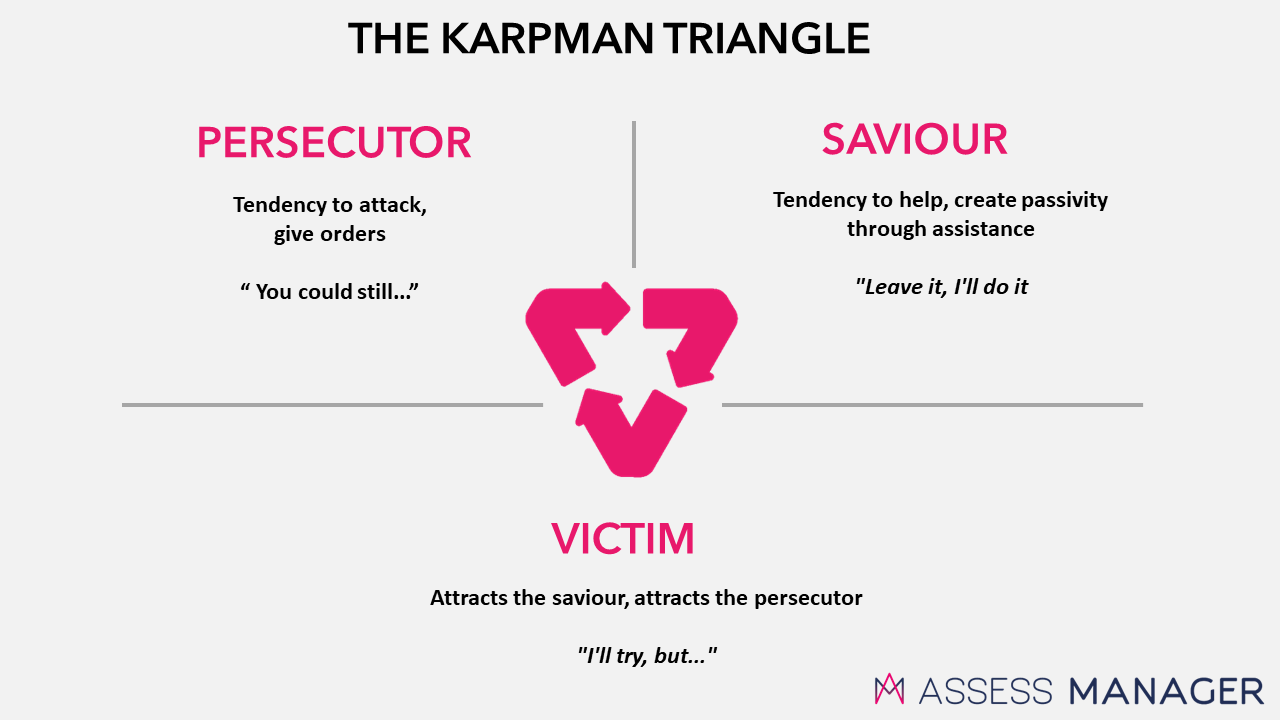A practical guide for managers, coaches and change management consultants.
How can Karpman’s dramatic triangle be used in companies and at managerial level?
How can it be detected?
Comment chaque rôle est-il incarné dans l’entreprise ?

Karpman’s triangle
Karpman’s triangle, also known as the dramatic triangle, is a triangle representing the relationships between three roles in a pernicious psychological game : the Persecutor – the Saviour – the Victim.
It is a game played between 2 people, 3 people or even entire groups of people.
Assess Manager includes the Karpman triangle test in its personality test.
The roles are interchangeable and the same person can switch from the role of persecutor to the role of victim and vice versa, several times in one day.
In the book on conflict management, the Karpman triangle is described in detail, with concrete examples from companies and group situations, as well as solutions for getting out of conflict. The book “Le management à porter demain”, published by EMS and written by Virginie LOISEL, director of Assess Manager, also details the impact of Karpman in companies.
The management and personality test assesses how a person positions themselves in these roles: victim/saviour/persecutor. Assess Manager assessments use Karpman to identify the posture a person is most likely to adopt (Personality Report – Conflicts page).
You can also make links with managerial courage, a skill in the management skills reference framework used by companies.
Diagram of Karpman’s dramatic triangle

From family psychology to business games with Karpman’s triangle
While these games stem from constructs that are put in place in childhood, they are reproduced everywhere: in couples, between friends and also in companies. This is the subject we are dealing with here: relational games translated through Karpman’s dramatic triangle in the workplace. The booklet on conflict management goes into more detail on this subject.
Summary table of postures and behaviours
| Posture | Characteristics | Communication | |
| Persecutor | High | Tends to attack, give orders. May bully or give the impression of bullying, humiliate and provoke resentment. Sees the “victim” as inferior | “You could still…” “You’ve forgotten again.. You’ve forgotten again… “Register of generalisation, use of superlatives. Assertions without proof. |
| Saviour | High | Tendency to provide ineffective help (fishing instead of learning to fish), creates passivity through assistance. Can also suffocate. | “If I were you, I’d do…” “You should…” “I’ll do it You should…” |
| Victim | Low | Seeks help and attracts both the rescuer to save them, but also potentially the persecutor to exist in their role as victim. Needs to draw attention to themselves and can do so if they are well trained | i can see that I’m not going to make it” “If he would at least admit that…” “Anyway…” “I’m not going to make it In any case…” “It’s always… “Register of generalisation in the complaint, devaluation. Asking without asking |
A game is a sequence of transactions that takes place according to a recurring formula, some of which are illustrated above. The game is played using hidden messages and innuendo. The response or riposte means that the initial player has succeeded in hooking his interlocutor by bringing him into the game, and each protagonist is able to play his part.
The film “Yes but” is an excellent illustration of Karpman’s dramatic triangle, illustrated in a family setting. Moving on to games in the workplace, here are a few classic scenarios.
Psychological games in the workplace – example of Karpman’s management triangle
“The boss is a persecutor, the manager is a saviour, the employees in the team are victims!”
This is very stereotypical, let’s face it. In the booklet on managing stress in the workplace, we illustrate Karpman’s much more subtle patterns, particularly in relation to scapegoating in a group. When the manager is in charge of the company’s objectives, he or she may take on the role of persecutor, with the employees looking for saviours. A classic case is the search for saviours in the manager, the unions or even outside the company, in customers for example.
In reality, persecutors can also exist thanks to the emergence of victims, accustomed to respecting a framework in which the authority embodies the role of persecutor.
When a manager assumes the role of participative leader, he or she can create a disruption that can be very disturbing for employees who are attached to their role of victim. By involving them in the process of reflection and even decision making, the manager no longer offers them the opportunity to complain about decisions, since they will have made them themselves.
The victims can then argue and criticise the manager for his lack of charisma: he can’t make decisions without them, he’s not calling the shots. The team then takes on the role of persecutor, with the manager becoming the victim. The boss can then be called in to save the day by appointing a new manager.
In this case, we’re dealing with a Karpman triangle as a group, rather than a restricted pair or trio.
The Karpman triangle test
In the personality test report, you will find the indicators of the Karpman triangle. Their purpose is to identify any operating tendencies that may exist for the person being tested.
If there is no pattern, we can conclude that the participant does not seem to spontaneously play Karpman’s dramatic triangle. The test does not evaluate the Karpman triangle exclusively; you may discover other transactional analysis indicators, in particular and potentially related ones (submissive child, for example). Karpman’s triangle in conflict management is a real key to understanding psychological games, and it is in the conflict management results that you will find all the results.
On the other hand, if the graph shows a marked tendency towards victimisation, it is all the more alarming if the employee is a manager, who has to convey the company’s values and policies. He or she may have difficulty motivating teams or demonstrating managerial courage, which is a skill assessed in the management test. They may feel that they are part of the team, siding with them if they have complaints. They may find it difficult to create solidarity in their work, and may favour solidarity in their complaints.
If the tendency is more marked in favour of the saviour, the manager is likely to be a very busy or even overworked manager. If, moreover, the “knows how to say no” indicator is low, the probability that this manager will do a large part of the work of his colleagues is very high: he likes to help, and he doesn’t know how to say no. His team may also have a problem with the “knows how to say no” indicator. His team may also have a low level of skills, as the manager needs to feel indispensable. To support this managerial profile, you can use the booklet on efficiency at work, which deals in particular with the ability to say no, as well as the booklet on delegation.
When the persecutor, or confronter as we call it here, is strong, the manager refers his teams back to their responsibilities and helps them develop their skills. This is a positive situation. If the indicator exceeds 50%, we can move from a confronting manager to a perverse tendency, i.e. towards the true persecutor: potentially humiliating and non-constructive critic.
- To confirm the positive or negative tendency towards confrontation, we can validate a few additional indicators such as empathy and the degree of dramatisation (in the stress management section). We can also look at the neuroscience graph to see if the manager is a dominant expert (critical sense often highly developed).
- If perfectionism is high, we can understand that the manager is demanding and accepts little margin for error. If it is weak, it is easier to conclude that the manager is playing a more perverse game, even if it is unconscious.
This is a diagnosis that should of course be verified during an interview. Under no circumstances can the results of a personality test alone be used to validate such information.
Karpman’s triangle in recruitment
Recruiting a victim (if the tendency is marked; >50%) for a managerial position is often dangerous. The candidate should be carefully questioned about situations in order to confirm or invalidate the diagnosis. A profile with a very strong saving result or a very strong confronting result is also a warning point. Socio-educational organisations in particular are increasingly using these tests to detect trends in profiles before committing to a recruitment decision.
If you’re working with a group experiencing recurring conflict or mood issues, it may be worth using the test to identify trends in the dramatic triangle. Because sometimes it’s whole groups that are at stake!
KARPMAN TRIANGLE SUMMARY
- Find the postures most easily adopted by a person in the results of the Assess Manager test concerning the Karpman triangle – an important indicator which completes the analysis of the manager’s posture
- In change management projects, identify people’s tendencies at an early stage so as to avoid the negative psychological games described in Karpman’s dramatic triangle
- Other useful links: Managerial courage, the result of Karpman’s triangle.
- File on emotional intelligence

To go further with Assess Manager


